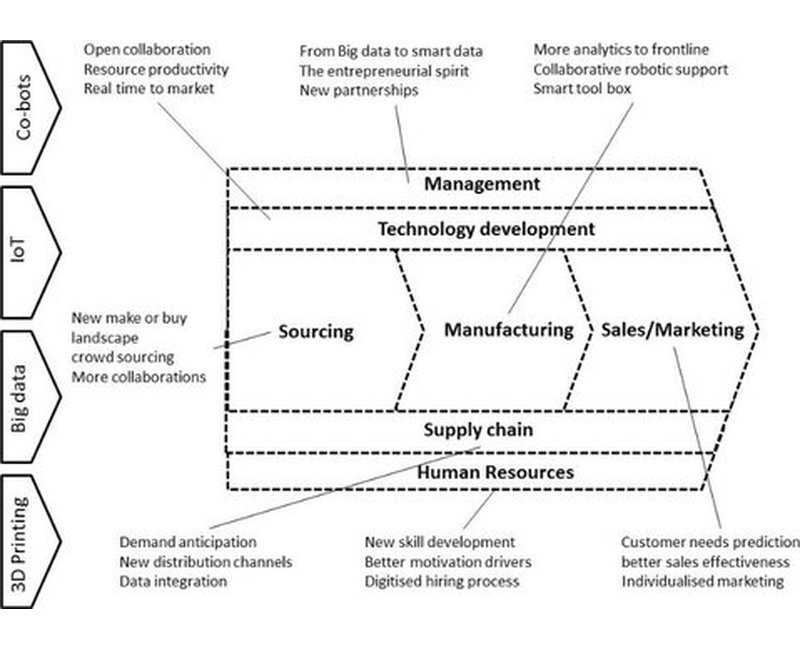
Published on 08/03/2016 | Strategy
We are currently going through a new revolution called Industry 4.0 driven by a number of factors, including new generation of affordable robotics (Co-bots), Internet of Things, Big Data and 3D printing. These four technologies are going to profoundly transform entire sectors while creating opportunities for newcomers. Specialists recognise that we have reached an important inflection point in digital transformation that businesses can no longer ignore.
The revolution is already well underway and will grow exponentially in the coming years. The development of new technologies will change the skills and processes in all industries, which, in turn, will need to be adapted. Although we are increasingly recognising the need to change, traditional obstacles to a successful transformation will remain. Leadership agenda priorities, identifying viable business cases, clear governance to drive transformation and developing employee skills will be more than ever key success factors.
To help in this transition, I would like to share some thoughts on changes I believe will be critical in several key corporate functions as presented below.
In addition to changing the nature of many activities, new technologies will allow for the creation of new relationships between the different functions into operational platforms dedicated to solve specific tasks or projects.
Here are some more details with examples.

In order to best take advantage of new technologies, management teams will need to first define which problems the organisation is trying to solve and which specific data they need to do this. Focusing on the right data is a challenge in a world of data overload. GE understood that its business could benefit from a software platform across the entire company and brought together 1000 developers in San Ramon, California, to do so. As a result, it developed “Predix”, which streamlines maintenance of all its assets. The first clients are already enjoying the fruits of this system.
As responsiveness and agility will become a prerequisite for survival for many incumbents under threat, promoting an entrepreneurial spirit by providing the right level of autonomy to collaborators will be a source of competitive advantage. Adobes Company has launched a new type of “idea box” for which an initial budget of 1000 USD has been allocated to prepare and test new ideas without any prior managerial approval.
As new technologies will merge physical products with information, new skills will be required for integrated solutions. For many companies, new alliances will be needed. Thyssen Krup, for example, teamed up with CGI to equip 1.1 million lifts in the world with sensors to improve real-time predictive maintenance. Teaming with start-ups or even creating start-ups within large organisations will also be a source of competitive advantage
As partnerships develop, engineering teams will need to be encouraged towards open innovation. This will require coaching and support to allow teams with different specialities and from different companies to work together towards a common target. Innovation will be as much in the service as it is on the product. Bosch, Tech Mahindra, Cisco, and National Instruments, for instance, are working on the future of manufacturing tools. Google and Johnson & Johnson are teaming up to develop robots for surgery.
As natural resources become increasingly scarce, as result of coping with global demand, engineering teams will need to consider the advantage of Industry 4.0 to create significant resource productivity. While substituting traditional materials with better performing and cheaper options will become more common, real time data capture will allow resource usage savings that clients will be looking for. Carbon fibre used on the Boeing Dreamliner is better for fuel efficiency. BuildingiQ allows optimisation of energy and water consumption in industrial buildings leading to an energy reduction of 30%.
3D printing will overcome current manufacturing constraints and will allow the creation of quicker prototypes to test the market. This more rapid and cheaper development cycle will support the entrepreneurial spirit required to keep up with market development. General Motors’ use of 3D printing for its Chevrolet Malibu allowed to reduce both prototyping time and final product weight.
Big data and Internet of Things coupled with wearable devices; for example, will bring more analytics directly to the frontline to ensure that the right intervention takes place at the right time. Virgin Engineering is developing applications for Sony Glasses for aircraft maintenance staff to access, check task sequencing and share real time data with expert systems.
Recent developments have seen robots becoming affordable and moving out of automotive and electronic assembly lines to support human operators in their daily tasks. UR3 robots from the Danish company Universal Robots are learning from the movements made and actions taken by operators and constantly mimicking these movements and actions so that the operators themselves will not have to undertake painful tasks.
Intelligence in tools and sensors on machines will make processes more reliable. Future torque ranges developed by Bosch sense which task is going to be performed and adjust the setting of the hand tool accordingly to guarantee work quality. Sensors in machines will allow better process reliability based on such real-time alerts.
Consolidating today’s unstructured data will allow robots to predict and anticipate customers’ future intentions and trigger the supply chain in advance. Amazon has a patent to predict their prime customers’ purchasing activity and ship out products early based on statistics and data aggregation.
3D printing will change distribution channels as production will be more scattered and minimum batch size revisited. In turn, local build-to-order strategies could fundamentally impact the manufacturer-wholesale-retailer relationship and perhaps reshape the entire shipping industry.
Data integration is one of the most important challenges to ensuring interoperability of connected products and creating new services. The supply chain will play a key role in this essential step. Some companies such as Plumchoice are positioning themselves as service providers to maximise connectivity through the supply chain.